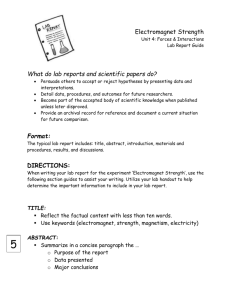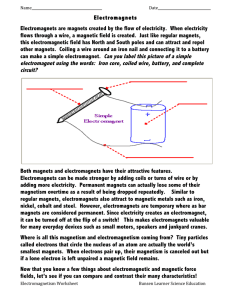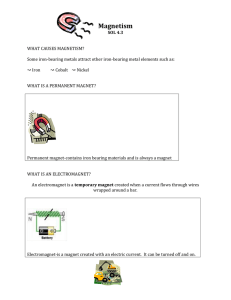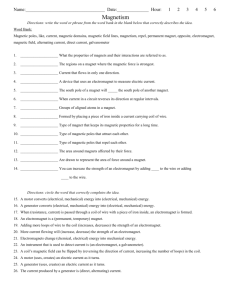Electromagnets - Appalachian Electric Coop
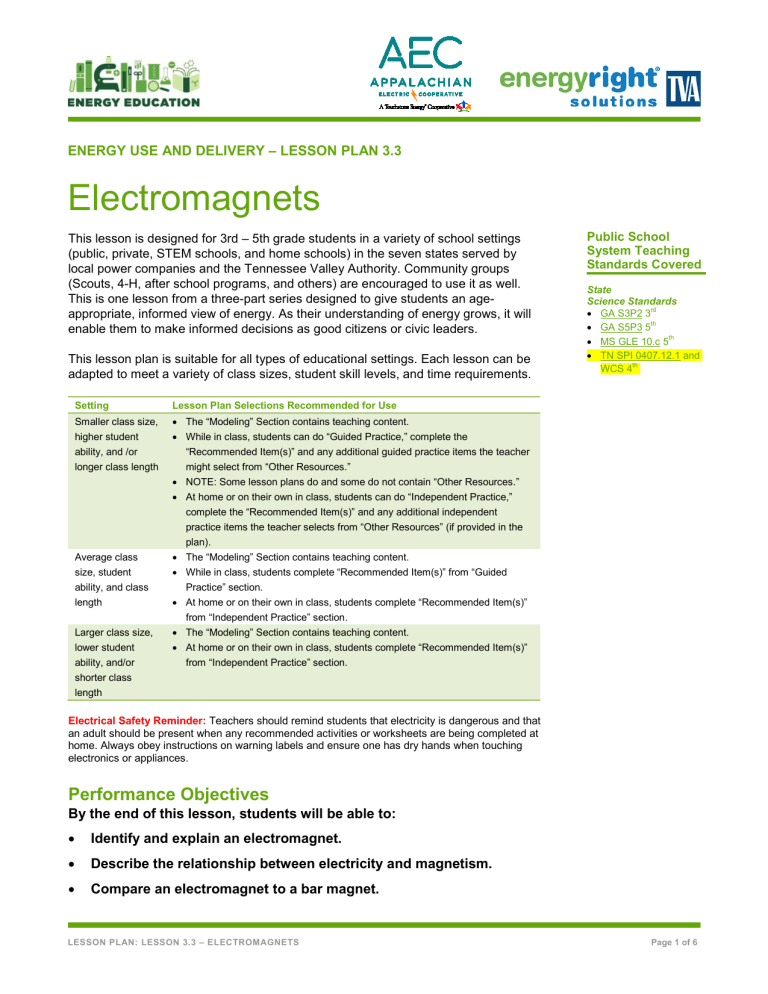
ENERGY USE AND DELIVERY – LESSON PLAN 3.3
Electromagnets
This lesson is designed for 3rd – 5th grade students in a variety of school settings
(public, private, STEM schools, and home schools) in the seven states served by local power companies and the Tennessee Valley Authority. Community groups
(Scouts, 4-H, after school programs, and others) are encouraged to use it as well.
This is one lesson from a three-part series designed to give students an ageappropriate, informed view of energy. As their understanding of energy grows, it will enable them to make informed decisions as good citizens or civic leaders.
This lesson plan is suitable for all types of educational settings. Each lesson can be adapted to meet a variety of class sizes, student skill levels, and time requirements.
Setting
Smaller class size, higher student ability, and /or longer class length
Average class size, student ability, and class length
Lesson Plan Selections Recommended for Use
•
The “Modeling” Section contains teaching content.
•
While in class, students can do “Guided Practice,” complete the
“Recommended Item(s)” and any additional guided practice items the teacher might select from “Other Resources.”
•
NOTE: Some lesson plans do and some do not contain “Other Resources.”
•
At home or on their own in class, students can do “Independent Practice,” complete the “Recommended Item(s)” and any additional independent practice items the teacher selects from “Other Resources” (if provided in the plan).
•
The “Modeling” Section contains teaching content.
•
While in class, students complete “Recommended Item(s)” from “Guided
Practice” section.
•
At home or on their own in class, students complete “Recommended Item(s)” from “Independent Practice” section.
•
The “Modeling” Section contains teaching content.
•
At home or on their own in class, students complete “Recommended Item(s)” from “Independent Practice” section.
Larger class size, lower student ability, and/or shorter class length
Electrical Safety Reminder: Teachers should remind students that electricity is dangerous and that an adult should be present when any recommended activities or worksheets are being completed at home. Always obey instructions on warning labels and ensure one has dry hands when touching electronics or appliances.
Performance Objectives
By the end of this lesson, students will be able to:
•
Identify and explain an electromagnet.
•
Describe the relationship between electricity and magnetism.
•
Compare an electromagnet to a bar magnet.
LESSON PLAN: LESSON 3.3 – ELECTROMAGNETS
Public School
System Teaching
Standards Covered
State
Science Standards
•
GA S3P2 3 rd
•
GA S5P3 5 th
•
MS GLE 10.c 5 th
•
TN SPI 0407.12.1 and
WCS 4 th
Page 1 of 6
I. Anticipatory Set (Attention Grabber)
Essential Question
What is the difference between a magnet and an electromagnet?
II. Modeling (Concepts to Teach)
Stockbyte/Getty Images
Magnets have two poles, “north” and “south,” and attract iron, or materials with iron in them, like steel. Opposite poles attract and like poles repel. For example, if there are two bar magnets with their ends marked “north” and
“south,” the north end of one magnet will attract the south end of the other. On the other hand, the north end of one magnet will repel the north end of the other (and similarly, south will repel south). An electromagnet acts the same way, except it is “temporary” – the magnetic field only exists when electric current is flowing.
The magnetic field of individual iron atoms is so strong that interactions among neighboring atoms cause large
LESSON PLAN: LESSON 3.3 – ELECTROMAGNETS Page 2 of 6
clusters of atoms to line up with each other. These clusters of aligned atoms are called magnetic domains . Each domain consists of billions of aligned iron atoms. When a current is sent through the wire wrapped around the iron-containing metal, the domains align so their tiny magnetic fields add to the wire’s magnetic field. This creates a large magnetic field that extends into the space around the magnet. The larger the current passing through the coil, the more the domains align, and the stronger the magnetic field will be. (See diagram below) http://www.magnet.fsu.edu/education/tutorials/magnetacademy/magnets/images/magnets-domains.jpg
So, an electromagnet is a device that creates a magnetic field through the application of electricity. It is created by wrapping a length of conductive wire, usually copper, around a piece of metal. A battery, or other voltage source, is used to introduce a current through the wire. This creates a magnetic field around the coiled wire, magnetizing the metal as if it were a permanent magnet. It aligns all of the domains in the metal in one orientation.
Electromagnets are useful because the magnet can be turned on and off by completing or interrupting the circuit.
LESSON PLAN: LESSON 3.3 – ELECTROMAGNETS Page 3 of 6
Uses of Electromagnets
The scientist Michael Faraday discovered electromagnetic induction . Electromagnetic induction takes advantage of the fact that a moving electrical current creates a magnetic field and a moving magnetic field creates an electrical current. Electric motors and generators use the idea of electromagnetic induction. In any electrical appliance, the motor is moved by the magnetic field produced by the electric current flowing from the socket to the appliance. A generator uses the opposite principle and an outside force, normally wind, moving water, or steam, rotates a shaft, which rotates a set of magnets around a coiled wire to create an electric current. This is how electric power is generated.
A few examples of things that use electromagnets are:
•
Loud speakers
•
MRI machines
•
Magnetic Separation
•
Lifting heavy iron-containing objects
III. Checking for Understanding
Teachers can ask students these questions to determine understanding of concepts.
REMEMBER
UNDERSTAND
APPLY
List the characteristics of magnetic domains. What are some uses of an electromagnet?
(Class discussion)
Predict what would happen if you didn’t use a conductor as the connective piece between the battery and the piece of metal? (Class discussion)
Examine the difference between a magnet and an electromagnet. (Class discussion)
EVALUATE
CREATE
Give a circumstance where you would need an electromagnet instead of a regular magnet. (Class discussion)
Create an electromagnet. (Teachers can demonstrate using the following experiment: http://www.sciencebob.com/experiments/electromagnet.php
.)
LESSON PLAN: LESSON 3.3 – ELECTROMAGNETS Page 4 of 6
IV. Guided Practice Ideas
Recommended Item
Build an Electromagnet (see below)
Experiments
•
Build an Electromagnet: http://www.sciencebob.com/experiments/electromagnet.php
•
Electromagnet: http://www.lovemyscience.com/electromagnet.html
•
Experiments with Magnets: http://my.execpc.com/~rhoadley/magindex.htm
Games
•
Electricity and Magnetism WebQuest: http://zunal.com/webquest.php?w=123653
Videos
•
The Science Behind Magnets: http://www.youtube.com/watch?v=MZtTVsIOA9c
•
Electricity and Magnetism Simple Electric Motor: http://www.youtube.com/watch?v=UY7LT3gNHXI
•
What is the Magnetic Field? http://www.sciencekids.co.nz/videos/physics/magneticfields.html
V. Independent Practice Ideas
Recommended Item
Scavenger Hunt: Find Magnetic Fields (see below)
Other Resources
Personal Practice
•
Label the Magnets Worksheet and Answer Key provided
•
Venn diagram: Teachers ask students to compare a bar magnet to an electromagnet using a Venn diagram.
(Ex. Draw two large intersecting circles. Label one circle bar magnet and the other circle electromagnet.) http://www.learninggamesforkids.com/graphic_organizers/writing/venn-diagram.html
Practice That May Involve Parents or Guardians
•
At-home Scavenger Hunt: Teachers instruct students to find 5 things in the home that produce magnetic fields with electricity. Write them on a sheet of paper. (Ex. Computer, appliances, etc.)
VI. Assessment
These items provide a check for understanding so teachers can easily determine whether concepts need to be reinforced. These items can be graded, if desired.
•
Label the Magnets Worksheet and Answer Key provided
•
Build an Electromagnet (if completed as Guided Practice, as shown above)
•
Venn diagram (if completed as Independent Practice, as shown above)
•
Scavenger Hunt (if completed as Independent Practice, as shown above)
LESSON PLAN: LESSON 3.3 – ELECTROMAGNETS Page 5 of 6
VII. Materials Needed
The following materials are needed for the Build an Electromagnet Experiment in the “Recommended Items” in
Guided Practice.
•
Large nail (about 3 inches)
•
About 3 feet of THIN COATED copper wire
•
Fresh D size battery
•
Some paper clips or other small magnetic objects
VIII. Closing the Lesson
In addition to the Essential Question shown below, teachers can reference Performance Objectives at the top of the Lesson Plan.
Essential Question
What is the difference between a magnet and an electromagnet?
Set3_LP3of6_Electromagnets_LPCname _FY2014Final
LESSON PLAN: LESSON 3.3 – ELECTROMAGNETS Page 6 of 6
WORKSHEET FOR ELECTROMAGNETS LESSON 3.3
Label the Magnets
NAME: _______________________
Objective: Students will be able to identify and explain an electromagnet, describe the relationship between electricity and magnetism, and compare an electromagnet to a bar magnet.
S
WORKSHEET: LABEL THE MAGNETS (FOR LESSON 3.3 ELECTROMAGNETS) Page 1 of 1
This page is intentionally blank.
Answer Key
ANSWER KEY FOR WORKSHEET: LABEL THE MAGNETS
ANSWER KEY FOR LABEL THE MAGNETS WORKSHEET FOR LESSON 3.3 Page 1 of 1

